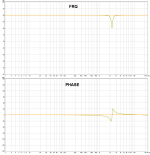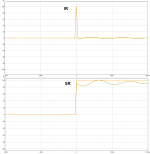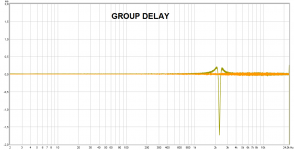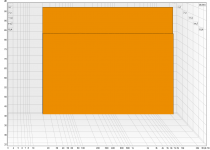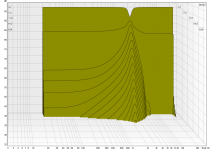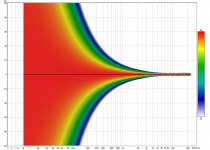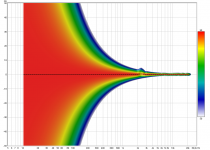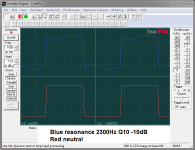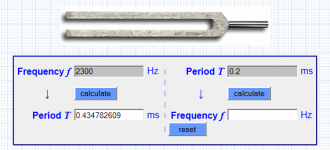How do you know? You haven't heard FF85wk. You are specualting based on far to little information.
And FF85wKeN does have correction... but at the source of the problem, not a band-aid as EQ does.
dave
Oh my, then tell me how do i buy one so i can send it to Rutcho or xrk971 together with a stock one and get some data on paper.
Oh my, then tell me how do i buy one so i can send it to Rutcho or xrk971 together with a stock one and get some data on paper.
Data on paper may give you some hints, but you will have to listen to them to evaluate all those things that we cannot measure. The stuff that is the difference between a good driver & a great driver.
X's data is really only good for about the top 5 octaves (resolution limited below that), so missing half the midrange and all the bass. Rutcho, i don't know.
dave
How do you know? You haven't heard FF85wk. You are specualting based on far to little information.
And FF85wKeN does have correction... but at the source of the problem, not a band-aid as EQ does.
dave
This is just one resonance at 2300Hz Q 10 -10dB and how it manipulate original waveform verse flat response.
Actual it looks like at datasheet FF85WK has this resonance then add rest of resonances and imagine how waveform get distorted and what your ears prefer, TC9FD is out of box uncorrected far better as a driver covering so much bandwidth.
Attachments
Last edited:
Data on paper may give you some hints, but you will have to listen to them to evaluate all those things that we cannot measure. The stuff that is the difference between a good driver & a great driver.
X's data is really only good for about the top 5 octaves (resolution limited below that), so missing half the midrange and all the bass. Rutcho, i don't know.
dave
The 85wken as used in your favorite FAST box, I believe is XO'd at about the same 350Hz setting I use. All that mid and bass would similarly not be fully represented either in your system. Have you even bothered to drop te Tc9 into your FAST? I believe it's an periodic 10:1 TL enclosure. Should work fine for TC9.
Our favorite FAST has A7.3eN in it. One of the FF85wKeN FASTs we did has XO at just over 300 Hz, the better ones lower the XO to 240 Hz. The most popular use of the FF85wKeN is FR in µFonken, µFonkenSET and i expect we'll see it in a lot of Frugel-Horn Lites.
The initial evaluation of the TC9 deemed it as not being capable of sufficient low level detail to be worth bothering with it anymore (much of the missing information is not in the bottom 4 octaves).
dave
The initial evaluation of the TC9 deemed it as not being capable of sufficient low level detail to be worth bothering with it anymore (much of the missing information is not in the bottom 4 octaves).
dave
A PeriodT at 2300Hz is about 0,43 mS then look post 104 group delay plot that shows error is more than 3 times PeriodT there and add that to amplitude error, audio harmonics around 2300Hz will be manipulated in both amplitude and timing and that could be the low level detail that planet10 often argue about.
Attachments
Well nobody can beat the "I deemed it not worthy" of being placed in a sacred cutout that probably is spot on match with the FF85Wk. Not a fair shake in my book.
X, around here there are many discarded FR that weren't worth spending any more time on. Only so much time in the day and we ar eonly interested in the "best" ones (our best -- as Scott points out there is no best). Literally drawers full of them.
dave
dave
X, look at your own test: http://www.diyaudio.com/forums/full...-comparison-2in-4in-drivers-round-4-a-37.html
It think it say's a lot that people, even from a recording, overall choose the more expensive drivers.
The TC9 and 10F have linearity curves and impulse responses that are so close that they are within the normal variants of a production line, yet they sound very different to the discerning listener. The 10F having a much more detailed and engaging sound.
Not to mention the TG9, that also is very close in measurements. It too sounds different. Described by some as grey and dull...
There are a parameters that are out of reach of the usual methods of measurement. They are certainly not magical or mystical, and also of course not unmeasurable. For some reason, they are just not measured very often. Be that for technical, sales or political/religious reasons.
It think it say's a lot that people, even from a recording, overall choose the more expensive drivers.
The TC9 and 10F have linearity curves and impulse responses that are so close that they are within the normal variants of a production line, yet they sound very different to the discerning listener. The 10F having a much more detailed and engaging sound.
Not to mention the TG9, that also is very close in measurements. It too sounds different. Described by some as grey and dull...
There are a parameters that are out of reach of the usual methods of measurement. They are certainly not magical or mystical, and also of course not unmeasurable. For some reason, they are just not measured very often. Be that for technical, sales or political/religious reasons.
No doubt the $100 10F sounds better. The question would a FF85WKeN in that same test been chosen over the TC9? P10 routinely denigrates the TC9 as lifeless cheap tv speaker at every opportunity he has. Really? Let's put them them to a blind test. It will never happen because as far as X is concerned, they are unobtanium.
Maybe we should pit the FF85's against a less expensive variant of the TC9, the TPY03 black cone which sells for $6 in India?
It measures darn good and sounds superb. It's kevlar so maybe not fair but the basket feels cheap, the terminals feel cheap, the motor looks like it thrown together sloppily. Doesn't seem to matter.
http://www.diyaudio.com/forums/full-range/282412-tpy03w06o0111-k-oem-black-tg9fd-2.html#post4561055

Maybe we should pit the FF85's against a less expensive variant of the TC9, the TPY03 black cone which sells for $6 in India?
It measures darn good and sounds superb. It's kevlar so maybe not fair but the basket feels cheap, the terminals feel cheap, the motor looks like it thrown together sloppily. Doesn't seem to matter.
http://www.diyaudio.com/forums/full-range/282412-tpy03w06o0111-k-oem-black-tg9fd-2.html#post4561055

Last edited:
We maybe don't talk enough of the voice coil diameter/length ratio and cone material, but at the end the ears benchmark is not so bad, it should be made with esl earphones to have a chance to be more concistant with tests... the meritt of the test is it convinced me to try the 10F for a DIY with less XO with the FAST Trynergy !
My last measurements of a passive physical filter on a tweeter with aluminium cone favors also the use of metal cone if we can avoid the peak of such material at the highest roll off. It's possible without electrical filter! No doubt more détails with air adaptation impedance is a good trade off, despite maybe all the problems than the wave-guides/horn adds with room ! Hey no perfect world !
My last measurements of a passive physical filter on a tweeter with aluminium cone favors also the use of metal cone if we can avoid the peak of such material at the highest roll off. It's possible without electrical filter! No doubt more détails with air adaptation impedance is a good trade off, despite maybe all the problems than the wave-guides/horn adds with room ! Hey no perfect world !
Last edited:
Brytt, i can make no sense from your last 2 posts.
dave
Why not it show one simple resonance verse linear response in various plots and how waveform is harmed in many matters by manipulating amplitude energy and time domain.
X, look at your own test: http://www.diyaudio.com/forums/full...-comparison-2in-4in-drivers-round-4-a-37.html
It think it say's a lot that people, even from a recording, overall choose the more expensive drivers.
The TC9 and 10F have linearity curves and impulse responses that are so close that they are within the normal variants of a production line, yet they sound very different to the discerning listener. The 10F having a much more detailed and engaging sound.
Not to mention the TG9, that also is very close in measurements. It too sounds different. Described by some as grey and dull...
There are a parameters that are out of reach of the usual methods of measurement. They are certainly not magical or mystical, and also of course not unmeasurable. For some reason, they are just not measured very often. Be that for technical, sales or political/religious reasons.
Don't think parameters are out of reach of the usual methods of measuremts, effect you see with TG9 TC9 10F that are so close at first look and you say yet they sound very different to the discerning listener, is in reality their response is different but you have to look for small less than 1dB but broad octaves response profiles. As example try EQ a 1kHz -0,5dB Q1,0 and turn it on and off while listening, it probably won't change much but then try with Q0,5 or 0,2 and a minus 0,5dB response change will sound as driver is swapped.
Barleywater that has knowledge to EQ every little minor peak and dip for drivers on design axis by using right weight of IRR/FIR combination had said somewhere that as soon two different drivers get within 1,5dB with exactly same steered pass band they start sound exactly the same.
At xrk971's comparison threads response was out of box uncorrected and therefor we saw when measurements revealed some nasty ones will change inputs waveform (signature) as the added single resonance in post 105 do.
If you want push put alpair 12p or 10 ,filter with small cap at the input of your amp , put plate amp on beta 15" that' all ... your kef is anemic on bass....
or SLOB with lowther by Nelson
PS there are a lot of nice 8" FR
or SLOB with lowther by Nelson
PS there are a lot of nice 8" FR
Last edited:
wesayso (appropriate name in this discussion), being polite is not something you are trying to stay, it's something you are by nature as a gentleman.
Anyway, you can be far more effectively venomous by being overtly polite, than by just slinging out generic insults.
If Dave says something is so, there is probably a very good reason. All those years of experience don't come cheap.
Im not doubting that the TC9 has some good qualities, and in an array things usually change by a lot with regards to driver characteristics. Not only does the individual driver only have to perform a fraction of the work, there is also the interference pattern of all those drivers, how they look to the amp and the different (some say unnatural) frequency dependent falloff of a line emitter and supposedly strange imaging qualities. Now, I haven't hear more than one line array, so I don't have empirical experience but there is science. This should not be construed as a negative criticism, just a call for a slightly more scientific healthy critical approach.
It should be very strange if there isn't at least some connection between bandwidth an price.
I know hifi is traditionally seen as the fools gold and quack paradise where bags of sand and repackaged electrical cables can be sold at ridiculous prices, but that big of a difference in cost benefit ratio (TC9 vs drivers costing several times the price) would have been found out and leaked to the saner regions of audiodom by now. Not even Tymphany themselves regard it as more than a good bang for the buck.
So you missed my point too? I am a polite person by nature, but get rubbed the wrong way by false claims. I have issues with that, I admit it. But my point was that it isn't needed to put down something or even someone if you can't back it up. A clear case of that is displayed here.
Believe what you will about that cheap Vifa driver. Obviously you didn't notice it's heritage. Check out the Vifa ring radiators if you get a chance. Plot them against Scan Speak's offerings costing many times more. Know why these (cheap) Vifa's do exist. Only then will you know why they perform above their price point. For a limited time when they were under the same roof the Vifa name was used by Scan Speak to test theories and ideas.
It won't be long anyway before the marvels disappear though. The connection between those two firms was lost long ago and even though the drivers are worth more than their price suggests they will be replaced with others that hold true to your limited point of view displayed above.
Good luck finding the right driver in the right enclosure. I'll just use science to make sure I'm listening to something decent. Do you want to know more about arrays? Drop in my thread. I can tell you my view why they do what they do. That didn't happen by accident. I can tell you in advance that slapping multiple drivers in a long enclosure isn't the key. Something more than that needs to be done to get it right.
If we had a way of measuring that, i would. We are closer to being able to do a proper blind test than that (take some bucks to do that).
And just because an objective measure does not exist does not mean the phenomenon is not there.
To quote Floyd Toole:
The only really important thing is whether you enjoy them, and obviously you do.
I do not enjoy a single pair of TC9. And if i had 25 x the cost of the TC9 i'd just buy a better driver, and use 1 or 2 /side.
dave
So, no evidence to back up your views. Just as I figured. And another misquote from one of the great researchers in audio. You do seem to do that a lot.
And still you manage to convince yourself you have a valid point. Conveniently making you "the judge" of finding the right drivers. I'm sure Toole spend most of his life measuring for fun and giggles and used his ears to determine the quality of the drivers he wanted his firm to use. 🙄 Just as you do. The resemblance between the two of you is striking! I had a different impression though. And I even interpret that quote differently.
I'm done here on this subject. I'll try and keep on topic from now on.
Last edited:
This is really independent of DSP. Once the information is lost, it is lost. Nothing you do will restore that lost information.
A DSP fixes the problem before it gets lost. 😀
Most recording studio's use DSP....
Its worth remembering that all we are talking about here is post production DSP.
What about Pre production DSP....?
All digital music is created and or mastered using DSP, most of this sounds very good, some of this sounds amazing.
There are lots of high end digital systems (CD or computer based) that dont use a dedicated post production DSP yet the music they enjoy is all DSP'd.
Just listen to any of the award winning CD's and digital downloads that are modern digital recordings of "classic" analog music.....They are fantastic!
We have been testing our A to D using some purist analog recordings including straight to vinyl or master tape and vinyl re issue's.....It's utterly transparent and sonicaly invisible.
It is not a ££££ DCS or MSB silly money unit....digital is reducing in price and getting better in performance each year.
The bottom line is:
DSP is a great Pre production tool for creating / mixing / Eq'ing music.
DSP is also a great tool for Post production mixing / crossovers and Eq'ing.....
Embrace the future!
Cheers
Derek.
Its worth remembering that all we are talking about here is post production DSP.
What about Pre production DSP....?
All digital music is created and or mastered using DSP, most of this sounds very good, some of this sounds amazing.
There are lots of high end digital systems (CD or computer based) that dont use a dedicated post production DSP yet the music they enjoy is all DSP'd.
Just listen to any of the award winning CD's and digital downloads that are modern digital recordings of "classic" analog music.....They are fantastic!
We have been testing our A to D using some purist analog recordings including straight to vinyl or master tape and vinyl re issue's.....It's utterly transparent and sonicaly invisible.
It is not a ££££ DCS or MSB silly money unit....digital is reducing in price and getting better in performance each year.
The bottom line is:
DSP is a great Pre production tool for creating / mixing / Eq'ing music.
DSP is also a great tool for Post production mixing / crossovers and Eq'ing.....
Embrace the future!
Cheers
Derek.
- Status
- Not open for further replies.
- Home
- Loudspeakers
- Full Range
- Full Range speaker project
